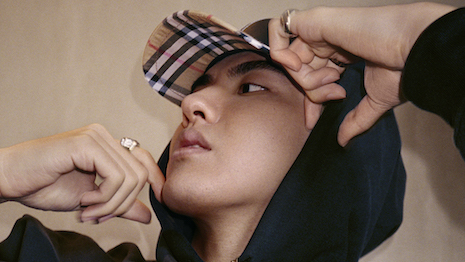Spending during Chinese New Year has been steadily increasing in recent years, with sales up 10 percent in 2018, according to new research from Fashionbi.
Consumers spent a total $145.9 billion on retail and catering during the seven-day public holiday, with categories such as travel and entertainment also seeing significant expenditures. As luxury brands looked to engage Chinese clientele around Lunar New Year, digital tactics that included celebrity endorsements or omnichannel interactions proved most effective.
“It's hard to judge which brand got the best results since we have no access to the sales figures of the special product launches and limited-edition collections,” said Yana Bushmeleva, chief operating officer at Fashionbi, Milan.
“Personally, I think that Longchamp brand had the most well-thought strategy. In contrast to many other brands which started the Lunar New Year campaigns at the end of January and the beginning of February, Longchamp announced its special capsule collection in collaboration with Mr.Bags at the end of 2017,” she said. “Opposite to other collections, there were no products in red color, the new bags which were designed together with Mr.Bags were made from a new leather type and in new sizes formats.
“Longchamp also used omni-marketing approach. The collection was promoted via WeChat account and directly from the app the readers were able to get all the information on the collection and collaboration and to register for the offline event at Longchamp boutique with Mr.Bags.”
Dogged digital marketing
According to Fashionbi’s “2018 Chinese New Year” report, Chinese consumers begin their preparations for the holiday days or weeks in advance. Data from Criteo points to upticks in spending on fashion, food and groceries and beauty in the weeks before Lunar New Year.
Looking to be part of this celebration, many brands rolled out digital efforts to engage the tech-savvy Chinese customer.
Taking the tradition of gifting red envelopes with money, or “hongbao,” into the digital age, both WeChat and Alipay offered consumers the ability to send these packets to friends or family electronically. WeChat parent company shared that 768 million people used WeChat pay to gift hongbao this year, an increase of 10 percent over last year.
Brands including Dior and Tod’s created branded hongbao that could be sent electronically.
Leveraging the power of celebrity, a number of brands partnered with stars for their Chinese New Year campaigns on Weibo. Dior worked with Angelababy, while Burberry sent out a video message from Kris Wu that was shared more than 12,000 times.
Partnering with local figures can help brands’ messages gain more traction on Weibo, since this type of content tends to perform well.

Burberry previously worked with Kris Wu on a capsule collection. Image credit: Burberry
Weibo was also home to a number of brand greeting cards, including ones from Chanel and Miu Miu.
Many WeChat efforts, on the other hand, were focused on driving conversions. Tiffany & Co., Bulgari and Louis Vuitton were among the labels sharing gifting ideas with direct paths to purchase.
Along with digitally-centric campaigns, omnichannel marketing was also key at reaching Chinese consumers.
Hugo Boss launched a lottery program on WeChat in which followers could win tickets for use in its stores. When they went to the stores and spent certain amounts, they were gifted items such as a Mahjong table game.
Prada similarly drove bricks-and-mortar traffic through both Chinese and Western social media by promoting its pop-up featuring robotic dogs.
Along with digital efforts, luxury brands rolled out canine-themed products in honor of the Year of the Dog.
Man’s best friend was incorporated into thematic collections and one-off editions. While luxury brands typically celebrate each Chinese New Year with special editions, this year’s zodiac sign inspired significantly more playful pushes (see story).
Social imperative
By 2020, Chinese social media use is estimated to hit 647 million active users, making a presence on local platforms essential for luxury brands aiming to speak to China's affluent and aspirational consumers.
According to Fashionbi’s trend report, China’s social media use has reconfigured how consumers in the Chinese market shop, with most opting for social commerce facilitated through platforms such as Weibo and WeChat. Developing a localized voice is a vital strategy for brands looking to make headway with consumers located outside the West, and in China, without social media it is nearly impossible to build awareness or conversions (see story).
With 78 percent of affluent Chinese consumers purchasing high-end goods on mobile devices, luxury marketers must amplify their online efforts to further facilitate mobile conversions, according to a report from Emerging Insider.
Emerging Insider’s “The Purchasing Habits of China’s Affluent Population” report found that as consumers’ comfort with mobile commerce has grown, digital marketing has become influential in the path to purchase and is likely to gain momentum. Of the affluent Chinese surveyed, Emerging Insider found that 22 percent said seeing an advertisement led to making a purchase, while 36 percent saw an item of interest via a social media influencer (see story).
"I believe the brands can reach higher impact on WeChat, especially taking into consideration the wide range of functions that the platform provides," Fashionbi's Ms. Bushmeleva said. "Gamification activities can engage the readers and attract the users to online and offline stores, or simple 'features' from the brand can also be appealing to the consumers, for example special gold stickers from Louis Vuitton.
"The WeChat lottery idea from Hugo Boss, an imitation of a slot machine, was also very interesting, by playing on the WeChat slot machine the customers were able to get the coupons for the shopping at the Hugo Boss brick-and-mortar stores.
"In other words, any innovation beyond the simple product promotion."
{"ct":"v2zgNscZ2QiGnoCnNPkEX9NKh6fECEqd50eQinUohyhGplfjzy1nM9cOibRUUY43eEbTFAD4OQ1IP8pv9aH5hpnJsWAKFXLEbHMjsSB2\/wLlmCJeReiwzcyz7wpKjpCs1\/E\/b6fmauE4vRgCEijaR\/wI5vZjmjBXRkQzFr0rGurtqVUE8pOyBjcY7W6j5\/j6Ikg6RGlixubG6PtxXf3D+eYmbC3Azs9VldqlW\/rzfLDrKSWFVWgWHluEPH8nQj9DwKvj3pbjgsG\/nTiMMz1eME06M7g7HF4p\/VzL2CLmWEdzJlOWK1lC\/KSODqz82LLEjUdpWfGR890pAe4SSg2MhmoByUYMr2Wk6xiaSGs8QIOorLibieosNFbYzExq2ajO6gnYii4Ke7jHm5ycrcIGPtdgSdrH+f0hRVwZHnYVp7pm1RSpGQd+48rq9paB8MS8cqZB+XXTiNlHYSBMWXgMaCSi6Ed12Y72QPl\/q2axBioyJDB0KMJF807WYgbTDC732UxMQf\/\/jtnwG2yqiqqlXCPY6Bjysrz5YQM8HIbuHbwgur9AnMhRT6\/A8GFS6ref2PBSW7wGVRSxmRzHds6HrLzxPnoLxO3aGwDcrAwtBPEC8nVZ9TTltlm0sOQJchvDrf8XgXIETtnw4q048pgqnUVjM4F2lOOyq3Dmjn4yDrTi5lRJo7nSsZ4PxNj41XOGOdJ8ZC6ygR1L7rb+T5wTfBJVnmhDdmZs9bIVRRQrA7N2aYcAkId7Z0CngG8zAnM9vxPXuc3ZYfG0SP6Ri5aKL9tyOET2qYxrKnPjeG9rvRYvtJn6tXnLsIbdmpkpJXJuajHAjpjbNeFuHe5XotN\/2by\/nX0hI+i3j91zzYOd3itIMdGZjkyX2MvvNNqXQaal5SOiHvRQUrKMJLB8kr7VlGEgf1zdpmVT1UfOGl0KStMPK\/SCmc1HwePg772fA6ZCetBKNlWAVf7Q7Rf2se4bzvXGkLy5vRSul8WVRrYzsIH5N3z9XynPWFWlIczjsdW6b7jg9LgOL2zkU86Z9dfdruVmWxRh34+5ev1xca0mCzjvxQ9AQINhmN\/qIjNe+aPbUpSpH5EeMKWHvXDfSDPyBlfLNfgrr40p2\/B\/fbbYLEU4OIyQFJdSuUffCramCylysFEDaDMFYNzdGCwF6YQuGq1d8vfRxZEO31eiug7ujJ2iMrS7e2Sp\/Mc7XN8vBy+Y92E26OKewNyGzqC4VTjKiuXHWWDu6tL5wlA5TRxl\/1jEDWhGHeBE8wORegYZcB3lOs3cw8M\/VEgpjA51bNiznTH7ztyLJCX6mXb0oi6rpCNfzriaOgGgsglTL1vI5iE\/985w9jTJiG49taEQwaaAqEyiAxYdpowaC\/V7JHRy7MU5RTNMl7wCTFLkY1s6BB7vnwiS9B+aMDmyApj5jPQVVuxiHORSFxK3cdS8K2pZnKxnrnYH1Ct3YsOlz0YES1aQ4ZW2xPDxF1tEy565Ex2XdVBPgARIEFgcl4ivbaJet8TKMTUgOyvz0Bha9ZlX8xPPPZ46S3ixbpnxkb8y2OBJyIb6\/jcWuzHszcAg\/5n\/t\/vPbwNqdZlG9lD0V+45Zdr8cKuY5FgZICwIeaPbpgZ9JBmJ4ToqyufEjesRBP9aYMwH6imH4sbyh29oX+cL0oeXylksTTUYIs1Inaxq51e1GpdOR1uPtfiv+19MErm\/pxUZeDc1DGTybAXsVLNWWMssxZ7fZbJrN9J1ysEa6o+dgZJuAUJQ3LGKldKVJeIr6KvpTqbNxxKRfauDdl1alVA4TWhkuZEuASyJN3nutirbGTIh21f0FA2N4J4bgrG3VPnHevd1RSIxile967J\/22NGimqqywDtV84yectzkOSX01TZcM8AELqajT882ZpMQopaRw9T36JP+x7EpXVrImC92YVnPQzifa7Xr3yjiV9SyF4T+jUlXUOaMajpGloRTeT3WeqvUncVU7kdes+NwXEDmBaOVEkS5yJ3mTOVs0ZvDUb7wS3HkwAxjLaXvt6pAxpoBNQjiLdT1tEb3STcpfL2CZLWWq9qbnyAfGK61xGhV+CVTW5GHLRM3HFz+knfXl5lex\/svIWwo4VDH2hpoX4E6a\/QqLwNU8F6PMNRW8sFH4UZrpcq0DFaFcid61iu+zWSwu2GGhmH3vxk7Nt8fJrumxEBXSaiBTE8Hf1BT5tO06u+GGuQg\/zeOsq7LoDISqmloLH1\/oo\/zUl\/jv9fvQeliPi93+wfEXFuIoJH5cFnZVmN0WZ1sEZ3Xw37jTnXP+jvgXklmR5n\/Ypwgh9Xr+HaI1XbTAHE2xChAdHCIuWB9nXk96L5j3Sqv9H0kCRHhE9LahVRfz6EFtnWHLJQA9ShQyf3jhXmOIHjExJKAzfGk2AONaeS4fvfOF5dve4BzmxQP30oY0Hjrm1NPPs3+mEiedqEIi9bGnrcdlQWbmSxyGJGRIgTfM3kAoH7PGY61pgUb9KqtOXtAfZj+6\/xEpqt+09vF1E2+Y2aoYkOr5JuXu\/3STDCSmhT4qiw1\/nsc0n2t1g9RJTrVxzEG1a059fWKMf7NCl4M4+anHwCSQ9PjbThb1GX7dRfRO1hL5\/SmLChHnrcGqaxV1LjBFMQPMjmqGQnW9XOtvIMc5kXCbfspikG86FzbrupC5TzWii8NX0G\/ult2fc9BStf8y\/TDCP1mlqfaK5PKeOyv5I1IasUINU0yMee\/\/Ey5XNbnZb6iFZJk1Bm6ogS03PDwc0BlYeH3k3Oc2\/ipa6ixjl0Fl9hjos0d1BG6U97xrn1sdzUQGCin58QtAjkHdx4AH+nG5nr2dty7vN5hl4v9XqDfzk4RmAiASobJVkCdYcUWkS6bt88lvx2ouSDWyVOUueIaJnAjtsWutc6KLkewPqNqKWQo830OLYfcmD4G8StkSEUNu5jzgmpgx9Jkws8Rvoccnyf117MG94NdGFrE4v4oZUwN0Fp5VpbeYh5oINdQD3VTA\/nRtfO7XT3mjL\/\/k4GnVuOl2Zm9BsyyFnJvmL7D6UWC6MgZgUvEXiRcT\/HAJL84dmra7pwAL6vO2jstxTKggaDqPM3Ez1QLsxVSywbrzPwFIxvW9AqxSPoyXFCB0EFT0LZ\/13wplyQB\/YQNsbJozLQ\/iG8uKJb8WkHIwLSRAdyF7Zz5zwrQBDznKT+0UsRCWEuZUzll5Uc+e94DknviJvfz0unfON2R4Xib12LPDbgJxwky\/Q9lO6ArxsU62h3ThAwK3RsPm5tBqbJfioN77hQr\/kBOKqXr8EtZz3CDAQ6YGs4vsonrOFaBY77SrOFotlOWzKNDonTgZxl3y0yN+O57wSPSwmHMZDjI9n4NxtuwscuxGjWtaQmjbzj\/nbvTRydUTPatqAerdOolYCbtbWWCq3ol15Q5MrwUVPxan\/PUz59KrNl9hrM09DbZgqIGKINNz896n0cl53Xthjpfj\/4Kw2reXy8fnQY1z4xwcz2mSm4a2XHRrHMsqrLD6Lj7MHBuQFILJS1cKWEcsHf4ElfKw5VqqwaXTWF4bXAUmodCgFl2+8JI0V1fbbZzjmNTHHQsqAn6pcRLYk5aYSxjZ1Z9m\/L9NX1LHsCV88iW\/dTX5HRnJnFk9VSCEjk3X7jSfByKcyrlCAzRahAKyvgiLG+Yj+93+01A+Jp7xU1OIjoLrCTHAnC0A+Ma2TgxKTRKSTKnFmAcungd7ZizaJjrGY6eUU0gRv7ilJeL7lCzEbNRE8F3RjUZYE4O3+VvlrC7ZkJcS1pq8usPwatOk3DCpx7CEyS2mgUr4JK1rvWxF6AdcoZTvxclmNals6EHsDN4t9oq0AuV5bSGeNBR6FtcY6IL15uNlP9e\/zGPqw5uMhuxXETtbbWffzV7WENDcP2ce5kOR21I0FUMs0X1iU16PrI5vywsC9x1xFzE6tBBx0ZVtQQqAf6iDgNN\/rMIDpcjidPtCp\/UhcZNR2vM0LwcA8NDepXH0ogFkW3K4w6Qll\/O3ibWCwdcUiXM1Bi7oc+4HDzAYp8BtDOtnlaRgNzzT1aseJMUOZvBOP9VyasXjLmzupt6RFWMmFnD+oXkjaRDwp6prHvWBaBOfwi9WHQ2OdlxaFcu\/BHQzN3fKP8SXBAD8lLqhrcC1Tf7bxEzshA+1DbZJvqo2g0UF0e5VruQEuvVxEk\/oio+4DKnToFARTO4qKQDET+l2nXvp5FPZ3NA0ZxprIB3x1z9XiDYeCyV1Zw7U2qMNd4qhvJ2Nj+u9JTnyM7fIx6TILI3nwf83IMwjzvXVPwxpHoCyGfWiWJ\/\/9KQKAP+SFpeWTZ9JVpCrwyVEm7QHgyZKXnGdR3i2ElABf+FYqR6az5m3OCE9hiCbZdg7GU8FbcWicuQkgjfElWIKiTd\/z+ohFo\/B3xo7be35\/QsXOZzKYCAP+ECBwZX0haZWScHVVa+AOD\/9W6MqcONDN6e0z90MvEywg2SAOtZrqZnWjTvcsW0DIc0Z3RWoqxOmdh0CYWUfVq+oLai+zXwqe8wwXR24ELUdMs91+N07YfyqoCS54d8uFaSbE37TVPBn3MtQwxUS4dXU5o0W2rJjtkVu4LNYq5GXAM1j\/FAVBo4w7KLDMzySIDekTVsC\/mBdr3PCDd3L92Jcj3ccoxaCUm8lzm2CxS6mO555rLvp5CL00OCM4\/u\/i3bYvRsKfR00X7fTUhLm\/Wnyz3Q+UixvuLcVSFTTdLv11E2L4SGE07WtsPFAnMyNStGFx6RkYGo\/1qURZh+r6goIGeuV9wxyt64v3HupzlMHBMcB9wojdAxEmwrj3ZQtGmsE5CDwMmUUJWT0VPaPEK45LZu2JO9wWw9SRUhASWvTmOtv\/IJYv6IG53UXvkzn05Z2Qdxj+0jEyFqca8+GkCmr7v82hWuL3wuBXF5GKMK75BRjFW2PSRm7yZMHFpFOiZ5nY8ZLMxDJLfmPupSp727uYVJSNfm1rZNzc3y3cFM\/zecML\/HNBDTmm5C6Bn4HvHE7u3kHve3DwCmYK3Z5PD0V2wbt6mSh6aNowyCd2F4AveNXDRN2avixvpDY5G+q0f+9Nkid8L1Q0Q+OozmlnHRbO4rF3FevngTAFcv2+dji4UwkrGdlXI1QIJrprMeTamzvVBn+z\/sAMPeXyAxWX7x2OntzCE8jPRxhLJP89pqtKE23hl04xnTqqR2sAVR1oLoJtD6yI9Swt7FYAS\/cmJ9BLsguW6yXiDpC3EWeZ+ZrCuVcN\/6CamoQ7tW6ugEBzUegpsTh9EiqP1Cz8wpidkOHaZKa2lj14NWlp\/AtsIOdYKNNbUjLXfjiabw009VQckfLUbjrCNDppfAeG0j\/6r09rzuzDVLhRjODNs6YwBBFgwj96oEmq1DI65PqH7RfFc4f\/thUUaKhkScKplm6EaYHiZWcvzpNrhbqm6WhpaO9hzh4tJ4Ge8vAwJsTIGe3NE9bANBpb3ZBb9fIDEHaODgw1SYis5RrGveOVh4qpilZYt2ylmpq6UtVkjpNpRF9p+ChRWZ3zQvubbyWCZIRTvwVT1AeoBTyO43gcWI6fkLlg0HwM1F7+sgqur4Xlyc5uUB7Z\/HP1\/wO6SsMQP0A3o+ChoaC+UbaKtcLn2wFUX\/XFDHS+QzVLq6ZrCL0yJ31J9W6CcDY6TI6jcWIQ81cM5lHZZBZnFt\/tkLuoJ\/MfFhrlYF6o88WHqOGuhWXxTnE1hhsXgNyGSLVw3UBGUY\/b4UjMvCPvPLdVTyQ\/F5ae\/6SeP3EHQPeCcdAXlpZTi2axngf9KgtZR8pIzcg9tUO3C78xMaLmivFWv0qIVLkvEIcq9T\/4kv5rpla656I+6qBGS84+ZIBLL0sh4I7TZ0DzPSHcWv7ueTME9HHHhaPADTtGaFmxutdB00bYnMdXdhYNlmRlUNdbnYcJiRm9t2CrcXCm+5BQ8HqQgpJMM24WATw0CeNuB5acpRNXmjVe1CK3C5BUNDqYqWsDOu1oH7w8cKswuDTUviowRUdXQjNXnxnKxwsgY\/j8WSzRoI40mGrXJvAN4LqXZZT90x5JHFvi7gNepqHl2Ps0ix3Ug0kYtYhNJonKYcweRjRxiqkpZ+TBY8GgWm9pIWkRc7r1D27R3IvBFobFWONKFmrp084VMzlhpPDQMTrv3RpJhQGoFbm0JsCk++hdBWhCNQUb94Nk9Ibfd8fFfRHo5sWk4sOWus8LBFpnGNcdUUvkRldvHIzZI2cTg7vJ3DJGYp5djPEQBv2tzhaSSLp9XS3694gmdc2sD9wJMklN235M73cTtQ7sdupBIoNLnba8rAdk1uwUczL1c8UlW2IfiAIlxhwVaLCasgVRTUS1h0szkyEEKOUUetYIgPN4mjLrGZMbmcgd+OnxNtV81gNph7EXWU9nQj0q2y2qAXnUdR8ym5WUt26WdlsI\/qKdJfrEaoJN5JrF9pXnAgh1YsWj1M45huJhaKcprcTYb7vgVCZ0M\/7U1rbgL88XOzPORx6QHwe8T2PZ7QSgyzFSTBjgwTz1vdZrkaUn19DME5jDjdQklYkHmZgIUvkv0QcsSvMUhF2gDSuJceEOES332IJBE3q2LkMI+oENAoyxhc4w2VksD5mJJGRn9JSYWY++fFf9RIAWQQbTkvj97oFYSrGU7SxQ97OTwuRd1SXeXyiEq9fqbigz2vtDQzCaRG2WpX\/dVgsqIMIPJ0Q51FDMBNLP8LOtwZmoih1AhcE0iUoVeaRsH\/yP+2blAHWx\/RkbspMoLqRVsKGFDnSZZKKywSBcjkTwyvqtu4cyjlWfHNc+O9gJxiDgQgOO6tLnpMFWWt9bc7iEydlxgP49Uctk7tx27FrUDVmIjT5MXeatJBYlxOjWBxbkufARwa9hCqGuSWwiySI\/rw0tw8Gl1XB5GBFQYIb\/fWpwQFJIVr0WaN3I9xtk6c7xmVvoi\/UbEuEatHKtUWf41S97EcGEUfmH9EIBNp8IQl88HhF0yXp8BIm8F8Bejm2IY9FnRZ6aBkp1biP41jv2kevztnD00\/iraYreBjvM8FY7RZitmMPzvEv3\/hcZyBIuWqRzhfqomf3ZWPTcn+Ab9fIQZkdYYq8Qao6svFXOxsZMvDxHsJfZc2ZMrb\/EQwf7VNFsxvoH\/b7pAg9G7FfMLQhB5nQpNo9GuHs6wmOONVssh\/rZojv4cRljcAcubfvbwnPFtC4bxWF9Kt8cjFqnOcCO2+vNqULEjjnLzZdfvtAevXCYX3Hi1ycQ9qcaME29JM01noH4WczU9WYRkMO2EkFmpCFOrhaqaE+SG2MmLgIMegBRwZjz7Rnvk1tS2G1tJd4YR\/Sc4LXmwIWY26jl2+JbsX8cGpdUYg\/W5lkJ+T\/3M+aeyGuR8sLfJeyVlE5omypGRdM0Y4pBLwREQ5BEEMLak9WRW8bHJerZq42hGXtC1rFgRXLyrEslpcIS5HdZJG66\/u+K0VIoHIq4ReU+c12T6MmGv7VAMJBvrpkuGUPPqWSgTfDEL95GnCuh2EiezRqxTPRZCQ1B6xFlcbEduj6N6VDSJuekdAzogLa\/QxvfqsvkDoLPNfs2E3LaLRyDzgheO+YedzcOKpuFqjTTG5kYrjIVYgs5AkY3RMQpi4CtHhEnjw8VUPxBYEj9xLhq6JxsaTXDFImJEjdk15pYMHqfq0EGhU228br8wRsB6uucE5CkJcAj7iYvqKrLRXcegJjzHScELdfyr3YK3NzrRTllOGLhgQrieY8ztfSi1Z\/nslyNzDGZI683jnON1BF\/2yWuPVQE7OHHu3SeY4U9MhRxilqps\/vOyg1Qo0OV6C7WQcSrenJ8jFx5az6QJjGjjvn3Vhe3m2ZCn8i7YoxyRqp58Xp77Qxlwbgku7wqBbV\/YEeO5tE8i8AMT5M5ICs7WCex23BlfJEvzwY5SLPboE5B66YMldaCnmKzg78Bsa6BgOJ4iX9v8HJK5eiQTNUSw+vttC0CGQTHnl44RdY4whf2WG2aK\/MarYTEjw0EDocLClxjO6scQKLs+fZPvlzk1BmTXb5roI03VsNB6AyUB2xCeCaVgb9l93thb7iEjSGE\/Ta\/ztjGK\/un8Pyh6f+G3d3tseKVaXqOFyeyboK9C5XeUiUgbqegXwrX7h0yT2mWOKNP2yFcRnEkavZWWnd4BHVCOtFclVE0LIue09sDeVos7xKnIgXrRPOC\/t+rqmcyybtf33fICFUPY2LnVkAxKKsyVDZ1X7Q1m2EWxmNEVCw6SBNIKbin9XiOopmAX\/ec\/ovYR7L1ORVhvVOLRO9Xf3eMl8RqR5aLLfHb\/eO1Y9nAeTuK\/O8dDExb14pCuhwwLqMJr03ywCZcg5+hBMY6kc6hlpFA5lnygOrvGlhlEpEXA1r2gofrb9vgEbLZ8VRiIsFH6oyhmrjh6jygc9rsh175OMVrv2s2pcPSRmMR\/wQckvgi7GSb6fhtDEaBu06TP3v0GBbS3XFNUnLHiEmcSFYDVeX2gBCaI0zuBkmSlhrYpq+XduJx2zXNNztDCeDugeJFA3XQIn7GfhLtrbMduQn4dWNDk8HkUCuBuhP\/LbwdPTSYw444NeGBQE1MvX3pYNJkUrzpB3p0eCJhBjX3VdOUQGf7FMqExJb49JFPXtX7UPeC69acipKAZ\/4xrk5HBTDdAGZIpxTHymyrbfWgTjVi+f49\/rHXnUeyePukYZk0IUzv8delBqQlyByuvsaL6U\/aAhZU2YRDmsILquEiMiJKbmQxtaXHyXI5vhZQEN6d5GmJ3rru9Y01RytjM1KUCyX\/Ul\/046\/qD6SsRDu5Fl\/3sRkagni85zhsAJp\/h9vKqh79RJhmzivblwe88MsbeUu9aJUFnqg\/HFH66ha2kRChOCPQpniId8jkNDizhmC\/F7gZH2sEiSPyPOrthIt99VQc6h8pTSIZH5ZpwgUVMHwmQTSBTApl9DtU9GvUlupXf8E+6qyX9mawteIDiGrfwDOGRjK\/qkWwzRRo0n0TMhbHTwalJAEqt+F9VVwOFLrjgJWOq6o1lD7SIkzgNkDzT9QTfNyNDP0YP+5bg8ID8trfuF8fvxzUGqK+AwM2LdP5Xy\/3vlzw6BjdMyZKSZMGZT8A+SizLApq\/iEpNHrIvPU9Ay8nLILAdb5r\/tQXWllhrzIvjxOm+4TVTl+nM21me2pBrOuoNyjO+X0bWMt8ZtLHqiLnFT2UDlNF+WDWWKCQG6blqLmwChj2CMnI0AmPvf0rPRywuvc6AuCDCC8TbngJPllhffSVenE8cu1XELP5E0TbaJXBvEMxuiKOLxYHQ42t8TTrlhXaImfPoFHy2tgnG8eUCiZDartGJol1l\/RxZaoP\/eDZUd2Jmzv\/0Vm\/\/1NqBtqf4PBoh50CWlknbWaygvvR1\/V7hhDudaOrawZZmq9vE9UrGFPYlylkQkXqMN7aXPyfomZpaVVEROPDyPI6Z6xYEoDW+U2Xop4H0cGa90B95EW2fNJV7MXN0yH9TEM2gJa4nYlL1YhdZy95VxNkkW\/76Y7\/NTShuJKRYqap7pVS4koNbBP6PWlRJCEqlzIB3bBBGdQfx46YjmATfsfgeHrZ+yW9b1WvXhHgUmCGf46ZBvVThcBaWEICrWTJJVVJSMl7YtijML2GG8d5FXziDkxmRz65AnKOJ3FndfQWH2j7QYHAAb5GgZ4xdtp2QEHhjCeXtGkb2GVRvWHjnpf8QMprGCwTv3JBcu\/4hU\/18isIh+LyH6WwpnFX1527+Lsi2x6EMjx4TtBluzAkK1v2APmrfFs2GOrlI88ZuuHwCR+DTV95WC78Vp9gPHmWFI7vR0aRL0ZGbGOqIe67TsTMWy6qNIfNTuShQB7Sp+xNys2H7UcT1LhGBeMXbglFAmQZ+4fYryQ0PNv+6c56zVPK1xFT38Ujp3NJAmxyWgIt+8MmIQDlpjZcwaihPMcnY35M7MxgomqQcvEwVCjM32YHlqZTtqkyVYXfnlulgcpdylx1H0q3a4WHF\/lW2yyYqKmNZjdm2Hy\/q1oS1E1GkLMs5H75NbrOqaN5F\/bjmWqV8fUnmPsQ+K4mZsOU5KGJfC5BBN8Pp8M6sBupOcRF9KtA1HrWrzUPFb8hEgcP8LtGUyWmYfUc+Jd484svtfynUiwQhZrktJXSD5lHtHX\/NKAFogNZyIr16sETz5Uut5Lw8HGobl5EPQfKx+sXYk1cx34t+hchvWA+7vpx7T4zOm7kn6XeV0vJWeMqc60OuTQrLd0YqM8RT5ybv02WGhnz5CI6FT6cNFGph8b14UvI44WLeDMST\/WaD+ac6wdAmCQo8EoNsEg1s4Zj0vCiH8JpiXAazjaLYOlnOwvrK8ZMSnfFa9eEWxd7uBTzsSlu4Q7SpOOEQ4OWD6pFOc3P\/XckVsKVgD2Sc2nN4QFesd3SWhEjBq9a357S5yokRHEC1npJmltVkMK\/vYwCpnWqSXCKzMgxlSWBedcS6FcdLcBUPP\/JaXxsHw+g\/eTezvoJx3cESUm217I8OWeCkLWgAJdS\/G8PiPvzwYTLit\/GrSQowNVBE3a68WTXGmLwneL5Yt83Wkj6dEvr56GJIQWhpEJrOVIKcZaXM5pVxqwTt5C4QhrZwzihLTt562pjuqEEj0wVpP8uvpExijxJKYpCM4b3zM2vZKeqV7qGoUGJ9sxqc9UOUmDOIKJohoDQBPyK6w0pCDq9zD0ltQGR3rZhhzJLD61mdztq7i4y4jA\/2ucusuzHPCIMa6x0ymabZgc1+LjAvUQF\/rUgGkiHCGWldjf5ZYxrIilfjdlEvCU2cptLoAD3EpPX3H8jkHkOJiu\/CCQW9mE6F6kQeWPJ0kCtePGWUkrNwWmRLO1tM6tttycWEpZHbipp1\/JFwQhkA5AVsouRHB8YfN91Lfw3TU3ehkpFeNUjUvNqqW2RspCyVztUftcIbAZt84XJBoXfoOmTgmpQCbCK\/FRhTDTaosGjX5Wm4p8VNV\/QGuNO6gFxtCUxw7iGMgP6zvszU41nDVm8ke0ae8gfhep3oQFly1eyPXmmH7osvx2i02HlOtvNrq+DbMj2dDx2CnhlUD8dm\/ZExTF85nsOtimW9oavN683zdqWOVMGdy4WGgyQGdKhueMHmDSy4nr7An\/n2nlZfT0Awe5pSdAj\/JY4PT0a55UmBt2QyRvtqTiuRVuAzoN41o6o0GJH3DYiMz4+jsXrn4kZ+tV8+JKeXN7fjuf7rDzPVGurqmpanqeLjjBX+21u\/LB3mjc\/muye2824XBSa742gHS5yXksEoYIJwNGYqZR3lHp\/RFOKZNe51umaEz3zoqc9cViMOU5pik1NlSBtORc5WyH1X5RrWtKHtyoSNEXn4dRLKCM6QRVvkOFtTfScKOAOngrEcT7Hr\/4aw25yEcUJAvwhMKoWgxtIUoewIzRxZwzwRvtm9NfjdDaUo6HFvRMoXMnznvqHjU\/hxtfm6swrv9fHswhDoLbcsVXi3uLejwEv5HbKT34V9vJWpT9zxcnDzM48oAqbVdI\/d0T26PAOb252hlbm6wj18QyNeRBkhmojKG4oph\/XlKkGvsLV4oocYQ67WUCbf8wMPa9mqpqeBriL0NkBKrgwOqnLW6Uz4sQ610YCr1PPacX3Z+kw2kZfJ7P3Jlf6Doz1Ifbxm8xmhHU+rbfUrchKxvQ==","iv":"bfe5b18fd0ab351a0caa2bc203857bcd","s":"26f751820c5b827f"}

 Influencer Mr. Bags collaborated with Longchamp for Chinese New Year. Image credit: Mr Bags
Influencer Mr. Bags collaborated with Longchamp for Chinese New Year. Image credit: Mr Bags